Poinsettias show up in homes every holiday season, but if you've ever wondered how to keep one alive past Christmas – you're not alone.
These bright, festive plants are often treated like short-term decorations, but with the right care, they can last a long time and even bloom again next year.
You don’t need fancy tools or a green thumb. Just a bit of know-how about where to place them, how to water them, and what they really need through the year.
In this article, I’ll walk through all the practical stuff – from picking out a healthy poinsettia to getting it to bloom again.
Whether you just bought one or want to keep one going from last year, this covers everything in plain terms.
Quick Overview of the Poinsettia Plant
| Feature | Details |
|---|---|
| Botanical Name | Euphorbia pulcherrima |
| Common Name | Poinsettia |
| Plant Type | Perennial shrub (grown as annual indoors in cool climates) |
| Native Region | Mexico and Central America |
| USDA Zones (Outdoor) | Zones 9–11 |
| Sunlight Needs | Bright, indirect light (indoors); full sun to part shade (outdoors) |
| Watering Needs | Water when top inch of soil is dry; avoid soggy soil |
| Bloom Time | Late fall to early winter |
| Bracts vs. Flowers | Bracts are colorful leaves; true flowers are the tiny yellow cyathia |
| Pet Safety | Mildly toxic if ingested; can cause skin or stomach irritation |
| Indoor Lifespan | Several years with proper care |
| Growth Habit (Outdoors) | Up to 8–10 feet tall and wide in warm climates |
How to Choose a Healthy Poinsettia Plant
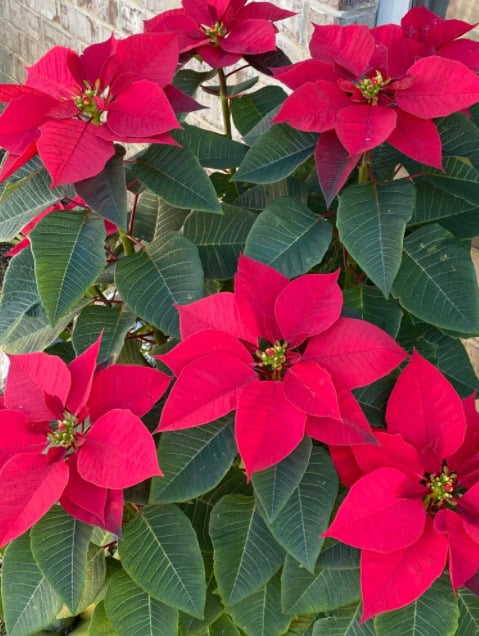
If you want your poinsettia to last more than a couple of weeks, it really helps to start with a healthy one.
Most folks go straight for the color, but the real secret is in the tiny yellow flowers right in the center – those are called cyathia.
The big red, pink, or white parts aren’t flowers at all – they’re actually just colorful leaves called bracts.
When you're picking one out, look closely at those yellow center flowers.
If they’re still closed or only slightly open (and not dropping yellow dust), that’s a good sign. It means the plant is still fresh and will stay looking good longer.
Also, skip the ones that are blue, purple, or covered in glitter. Those are usually white or cream-colored varieties that have been spray-painted to look fancy.
It might seem fun, but those dyes and coatings aren’t great for the plant, and when it reblooms, it’ll just go back to its natural color anyway.
A good, healthy poinsettia will also have:
- Full, lush bracts with no wilting or browning
- Sturdy stems that aren’t drooping
- No signs of bugs or mold on the leaves or soil
Taking a few minutes to check these things at the store can make all the difference once you bring it home.
Preparing Your Poinsettia After Purchase
Once you get your poinsettia home, there are a couple of simple things you should do right away to help it settle in and stay healthy.
Remove or Puncture Decorative Foil for Drainage
Most poinsettias from stores come wrapped in shiny foil or placed in decorative pots without drainage holes.
It might look nice, but if water has nowhere to go, it’ll collect at the bottom and start to rot the roots. That’s one of the fastest ways to lose the plant.
If you want to keep the foil, that’s fine – just turn the pot over and poke a few holes in the bottom so extra water can drain out.
Even better, take the plant out of the foil when watering, let it drain completely, and then put it back.
Best Soil and Pots for Poinsettias
If you ever need to repot your poinsettia – whether it's right after purchase or later on – use a lightweight potting mix that drains well.
A mix with peat moss, pine bark, or perlite works best. Avoid anything too heavy that stays soggy.
As for pots, go with plastic or clay containers that have drainage holes at the bottom. You don’t need anything fancy – just make sure the water can escape after each watering.
Getting these basics right at the beginning helps prevent common issues like mold, droopy leaves, or root rot later on.
Where to Place Poinsettias Indoors

Poinsettias don’t need a complicated setup, but where you put them in your home makes a big difference in how long they stay healthy – and whether they’ll bloom again.
Ideal Light Conditions for Bract Color
These plants like bright, indirect light during the day (just like many of the best indoor plants do).
A sunny window is a good spot, just make sure it’s not blasting the plant with direct sun all day – especially in warmer climates. Too much direct sun can fade or burn the colorful bracts.
If you’re using indoor lighting, incandescent bulbs actually bring out the color in the bracts better than most fluorescent lights.
It won’t hurt the plant either way, but if you want those colors to stay vibrant, warm light is better.
Why Rotation Helps Promote Even Growth
Poinsettias tend to grow toward the light, which can make them lean or look lopsided over time.
To avoid that, rotate the pot a little each day. Giving all sides of the plant equal light helps it grow more evenly and keeps it looking fuller.
This becomes especially important if you're trying to get the plant to rebloom for next year – balanced light exposure is key to even development.
Keep Poinsettias Away from Cold Drafts and Windows
One of the easiest ways to damage a poinsettia is to place it too close to a cold window or in a drafty spot. Even if the room feels warm, the cold from the glass can burn the leaves if they touch it.
Try to keep the plant in a room that stays around 65 to 75°F (18 to 24°C) during the day, and not much colder than 60°F (15°C) at night.
Avoid placing it near heaters, vents, or frequently opened doors – sudden temperature changes stress the plant out fast.
How to Water Poinsettias the Right Way
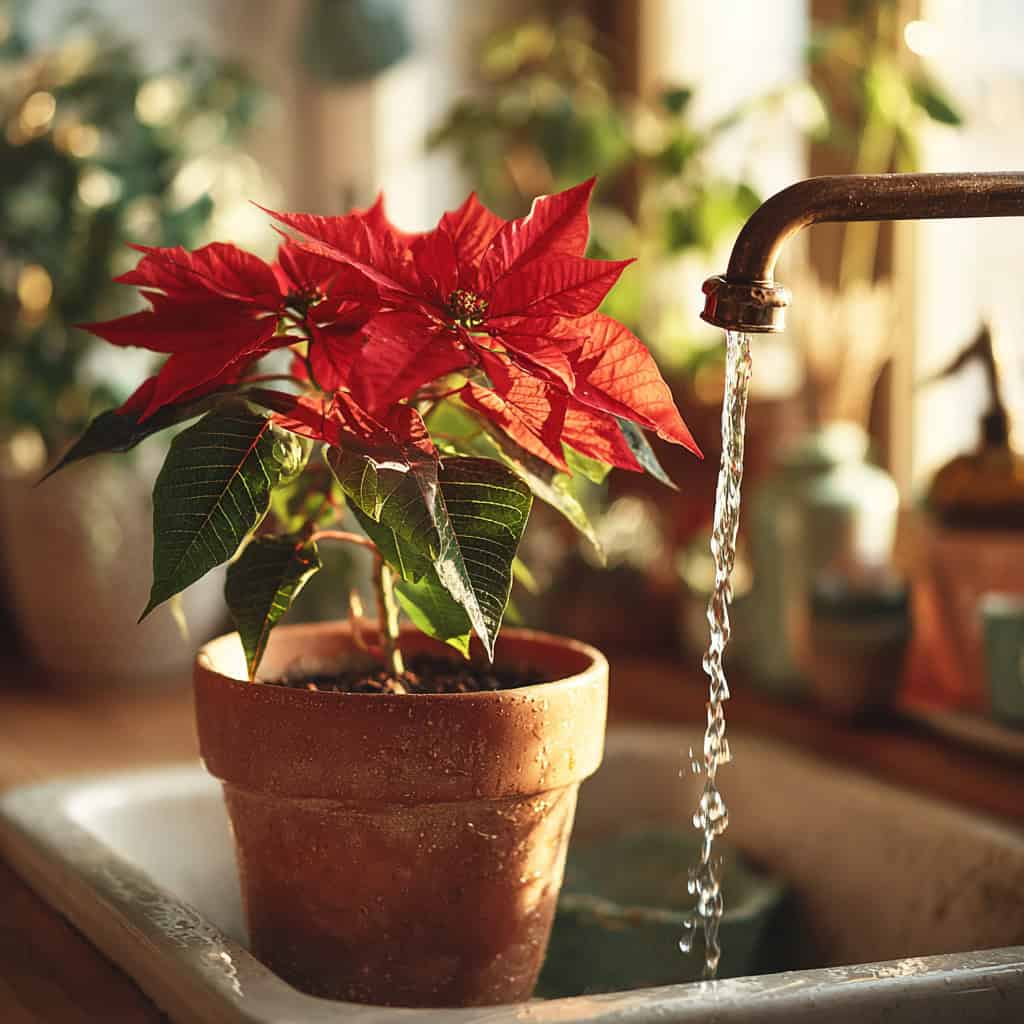
Watering is one of the trickiest parts of keeping a poinsettia healthy.
Too much water, and the roots can rot. Too little, and the leaves will droop or drop. But once you get the hang of it, it’s pretty simple.
If you’d like a broader guide, here’s a post on how to water plants indoors that covers general houseplant care.
Use the Lift Test to Know When to Water
One of the easiest ways to tell if your poinsettia needs water is by picking up the pot.
If it feels light, the soil is probably dry and it’s time to water. If it still feels heavy, there’s enough moisture and you can leave it alone for now.
This works especially well if your plant is in a plastic pot with a lightweight mix like peat, bark, or perlite – which most store-bought poinsettias are.
You can also stick a finger into the top inch of soil – if it feels dry, it’s safe to water.
How to Water Poinsettias in the Sink to Prevent Rot
When it’s time to water, the best way is to set the plant in the sink. (If you enjoy gardening DIYs, you might like these creative garden sink ideas for your space.)
Gently water the soil until you see water flowing out of the drainage holes at the bottom. Let it sit and drain fully before putting it back in its decorative pot or foil wrapper.
This method makes sure the roots get a good soak without leaving the plant sitting in extra water, which can lead to root rot.
Avoid watering just a little at a time – shallow watering doesn’t reach the whole root system.
Also, try not to let the leaves get too wet. Water left on the leaves in cooler conditions can lead to spotting or mildew.
How to Increase Humidity for Healthier Plants
Poinsettias don’t like dry air. If your home gets dry in the winter – which is pretty common when the heat is running – the leaves can start to curl, dry out, or drop early.
A little extra humidity goes a long way in keeping the plant looking good.
Grouping with Other Houseplants to Boost Humidity
One of the easiest tricks is to place your poinsettia near other houseplants.
When plants are grouped together, the moisture they release into the air helps raise the humidity in that small area.
It’s a simple and natural way to give your poinsettia a better environment without needing any fancy tools. If you’re building a collection, try mixing in easygoing houseplants like snake plants.
If you don’t have other plants, another option is to set the pot on a shallow tray filled with pebbles and water – just make sure the bottom of the pot isn’t sitting directly in the water.
This keeps the roots dry but lets moisture rise around the plant.
Just aim to keep the air around the plant from getting too dry, and you’ll notice it holds onto its leaves and color longer.
How to Grow Poinsettias Indoors from Cuttings or Starter Plants
If you live in a cooler area or simply want to keep your poinsettias in pots, you can grow them indoors from cuttings or nursery starters.
With the right setup, they’ll do just fine on a windowsill or plant shelf.
Growing Poinsettias from Cuttings in Pots
The best time to take cuttings is mid-July through mid-August.
Use clean scissors to snip off healthy shoots about 3 to 4 inches long. Cut just below a leaf node, remove the bottom leaves, and dip the cut end into rooting hormone.
Plant each cutting into a small pot filled with moist, well-draining medium like vermiculite or a peat-perlite mix.
Keep them in a warm, humid area out of direct sunlight, and mist them regularly to keep the humidity up. Within a few weeks, you should see new growth – that means roots have formed.
Transplanting Rooted Cuttings to Larger Containers
Once the cuttings are well-rooted and growing, it’s time to move them to a regular indoor potting mix. Use a container with good drainage, and make sure the soil stays lightly moist (not soggy).
If you’re new to choosing and setting up pots, you might find my guide on container gardening for small spaces helpful.
Place them somewhere with bright, indirect light, and continue watering when the top inch of soil feels dry.
These young plants will keep growing through fall and can develop into nice, compact indoor plants if trimmed correctly through the season.
Growing Poinsettias from Nursery Starter Plants Indoors
If you’ve picked up a small poinsettia from the store or garden center, treat it like any other indoor plant. Keep it in a bright spot away from drafts, and water thoroughly when needed.
Make sure the pot has drainage holes, and remove or puncture any decorative wrapping to prevent soggy roots.
With steady care, these starter plants can be grown year-round and even rebloom if you follow the right schedule.
Year-Round Poinsettia Care Schedule for Reblooming
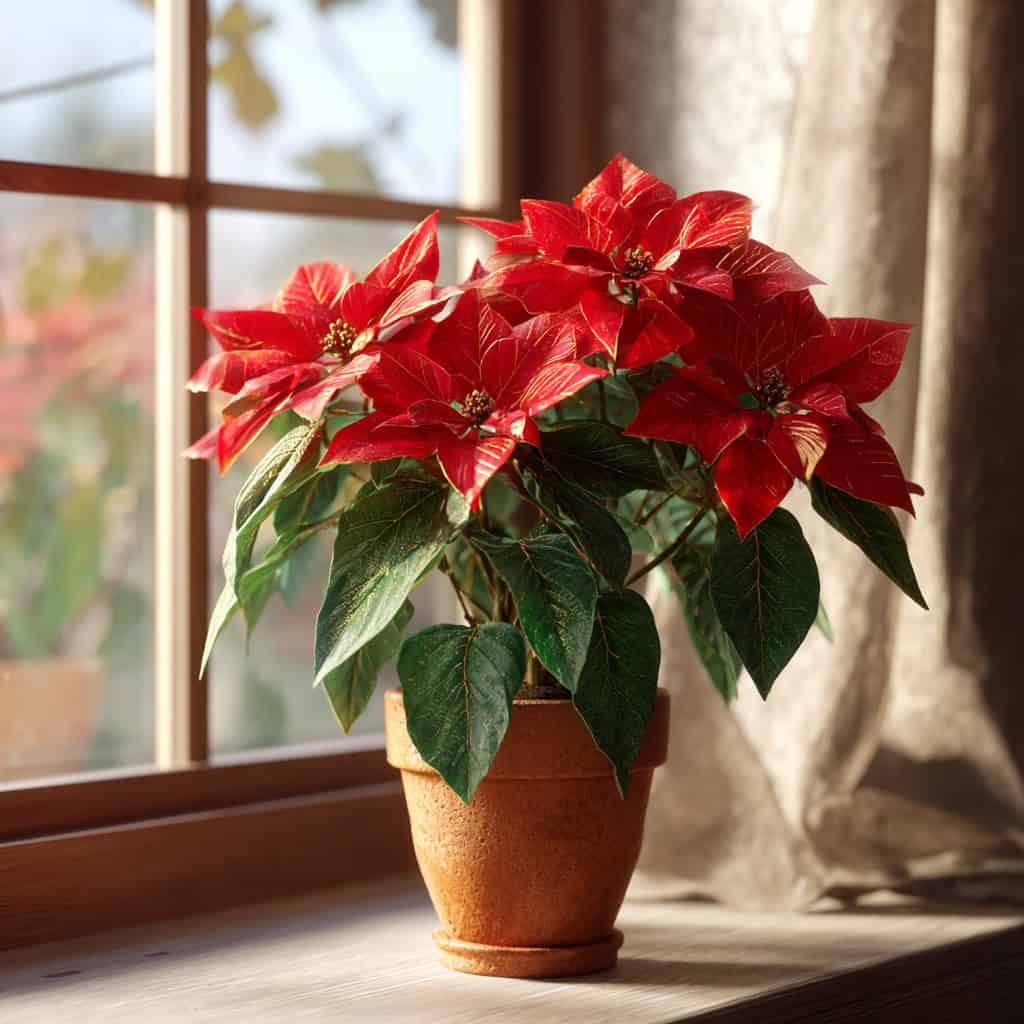
If you want your poinsettia to bloom again next year, it needs a little attention throughout the year – not just in December.
Below is a straightforward care schedule, using familiar holidays to help you remember what to do and when.
Valentine’s Day: Cut Back Tall or Leggy Growth
By mid-February, the plant may look stretched out or tired.
Trim it back to about 5 inches tall to encourage fuller, bushier growth. Don’t worry – this kind of pruning helps the plant reset and grow stronger.
St. Patrick’s Day: Prune Again and Add Soil if Needed
Around March 17, give the plant another light pruning – just clean up any faded or weak parts. If the soil has settled and you can see the roots at the surface, add a bit more potting mix to cover them.
Memorial Day: Encourage Side Branching
At the end of May, trim 2 to 3 inches off the ends of the branches. This helps the plant branch out more, which gives you a fuller shape later in the year.
Fourth of July: Boost Growth with Sun and Fertilizer
In early July, do another trim if needed, then move the plant outdoors into full sun (if your weather allows it).
Start fertilizing regularly and water more often to support the plant during its main growing season.
Let it grow freely through the rest of summer. This is when the plant builds up strength for blooming in the fall.
Following this basic schedule makes it much more likely that your poinsettia will bloom again – and it keeps the plant looking good year-round without much guesswork.
How to Prune and Maintain Poinsettia Shape
If you want your poinsettia to grow into a full, bushy plant instead of getting tall and spindly, pruning at the right time makes a big difference.
This is less about keeping it alive and more about helping it grow in a balanced, compact way.
Seasonal Pruning for a Fuller Plant
During the warmer months – especially spring through early summer – you can do light pruning to help the plant branch out.
Every time the stems grow several inches, you can snip off the top inch or two. (Sharp, clean shears are best – check out my list of must-have gardening tools if you need recommendations.)
This encourages the plant to send out new growth from the sides, which gives it a fuller shape.
Don’t worry about doing it perfectly. Just cut above a leaf node (where the leaf attaches to the stem), and the plant will respond by growing more shoots from below that point.
You can do this kind of shaping every few weeks during the growing season.
Final Pinching Window Before Bract Formation
If you’re aiming for your poinsettia to bloom again for the holidays, you’ll want to stop all pruning and pinching between August 15 and August 25.
After this point, the plant starts preparing for bract and flower development, and any cuts made too late can throw off that timing.
Once you’ve done your last round of pinching in late August, let the plant grow untouched from that point on. That gives it time to form buds and color up properly by late fall.
How to Grow Poinsettias Outdoors in Warm Climates
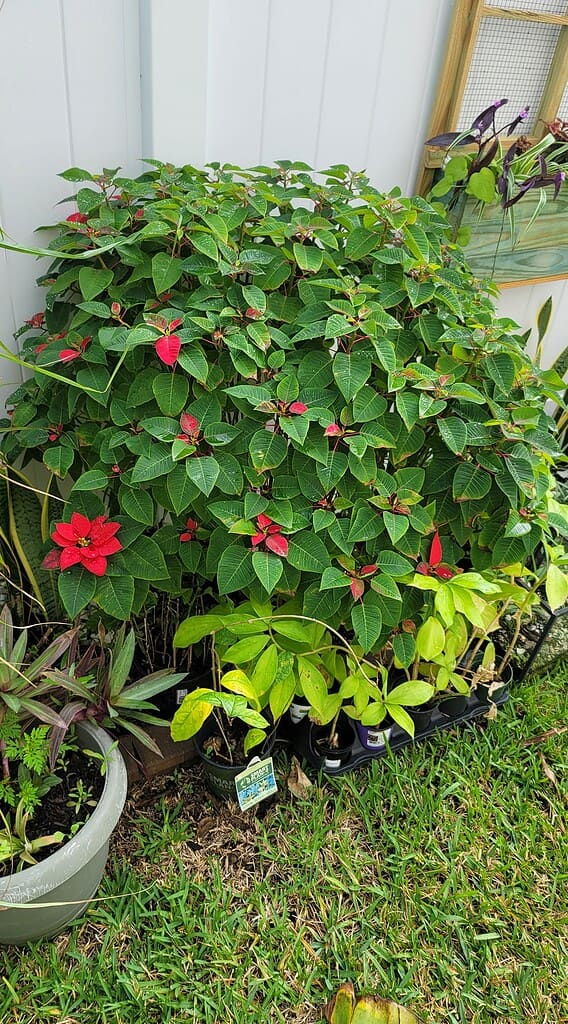
If you live in a mild climate (USDA zones 9–11), you can grow poinsettias outside in the ground. In the right conditions, they’ll grow into large, colorful shrubs that come back year after year.
Planting Poinsettias as Shrubs in USDA Zones 9–11
Choose a spot with full sun to light afternoon shade, and plant your poinsettia in well-draining soil.
Give it plenty of room – these plants can grow up to 8 to 10 feet tall and get just as wide when grown outdoors.
Water regularly during dry spells, but let the top of the soil dry out between waterings. If you’re planting during the hotter months, keep the soil evenly moist until it’s established.
In areas where temperatures occasionally dip below freezing, either plant in a large container that can be moved, or cover the plant during cold nights.
Using Summer Rain and Sunlight to Strengthen Outdoor Plants
Summer rain can do a lot of good for outdoor poinsettias – especially if you’ve been keeping them in pots.
A light, warm rain helps clean the leaves, refreshes the plant, and gives it a natural boost. Just make sure your container or garden bed drains well afterward so the roots aren’t sitting in water.
With a full season of outdoor sun and air circulation, poinsettias tend to develop stronger stems, healthier leaves, and a sturdier root system, which helps them perform better during the bloom cycle in winter.
Interesting Facts and Lesser-Known Benefits of Poinsettias
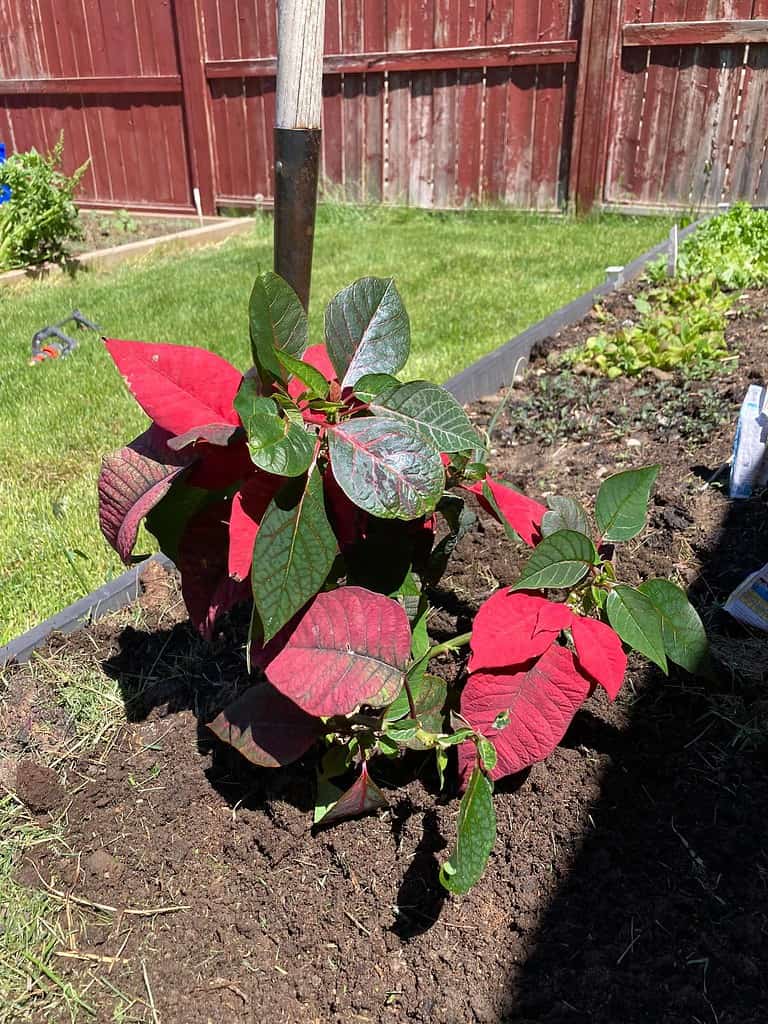
Poinsettias are best known for their bright, colorful bracts during the holidays, but there’s a bit more to them than just seasonal decoration.
Here are a few lesser-known things about these plants that you might find useful or just plain interesting.
Can Poinsettias Clean Indoor Air?
While they’re not miracle air purifiers, poinsettias can modestly improve indoor air quality by helping remove small amounts of pollutants like formaldehyde.
Don’t expect a huge difference, but when grouped with other houseplants, they do play a small part in freshening up indoor air.
Traditional and Cultural Uses of Poinsettias
In their native regions of Mexico and Central America, poinsettias have been used in traditional practices for generations.
Some communities have used the plant’s milky sap in folk remedies, though there’s no solid scientific evidence to support medical use.
Today, they’re mostly celebrated for their symbolism and beauty during the winter season.
Not As Toxic As Most People Think
Many people believe poinsettias are highly poisonous, especially to pets or kids. The truth is, they’re only mildly irritating if ingested, and large amounts would need to be eaten to cause any real harm.
That said, it’s still best to keep them out of reach, especially because the sap can cause skin irritation in sensitive individuals.
Bracts Aren’t the Flowers
The red, pink, or white “petals” are actually bracts, which are modified leaves.
The true flowers are the tiny yellow parts (cyathia) in the center. Once those little flowers open and drop pollen, the plant usually starts winding down for the season.
The Plant Can Live for Years
With the right care, a poinsettia doesn’t just survive past Christmas – it can live for many years. Some people have kept the same plant going for 5–10 years or more.
It just needs proper light, regular pruning, and attention to its yearly cycle to keep blooming again and again.
Keep Your Poinsettia Thriving All Year Long

You don’t have to toss your poinsettia after the holidays – with a little care and attention, it can grow, bloom, and brighten up your home for years to come.
From choosing a healthy plant to knowing when to prune and how to water it, the steps are simple once you understand what the plant needs.
Whether you’re growing indoors in pots or planting outdoors in a warm climate, just take it one season at a time.
Stick to the yearly care schedule, and your poinsettia will reward you with color and growth that lasts well beyond December.
Got any questions or tips of your own about growing poinsettias?
Drop them in the comments below – we’d love to hear from you!
Frequently Asked Questions
1. Can poinsettias bloom again every year?
Yes, they can rebloom if you follow a year-round care routine. This includes seasonal pruning, proper light exposure, and a dark period in the fall to trigger bract color.
2. Why is my poinsettia dropping its leaves?
Sudden temperature changes, drafts, or overwatering are the most common causes. Make sure it’s not near a cold window or heating vent and check that the roots aren’t sitting in soggy soil.
3. Are poinsettias toxic to pets?
Poinsettias are mildly toxic, but not deadly. If a pet chews on the leaves, it may cause drooling or an upset stomach. It’s best to keep them out of reach just in case.
4. How long can poinsettias live indoors?
With the right care, poinsettias can live for many years. Some people keep the same plant going for over a decade by following a good yearly care cycle.
5. Do poinsettias improve indoor air quality?
Yes, a little. While they aren’t as effective as some other houseplants, poinsettias can help clean indoor air in small ways, especially when grouped with other plants.
Ready To Transform Your Garden?
Are you looking for the best way to layout your garden beds? Maybe you're feeling a bit stuck on how to make the most of your space?
We’ve got you covered! Check out our 101+ Garden Bed Layout Ideas for your next raised bed project. This guide is filled with creative and practical ideas that can help you design a garden that fits your style, whether you’re just starting out or have been gardening for years.
Get your copy today and get inspired to bring your gardening dreams to life.

